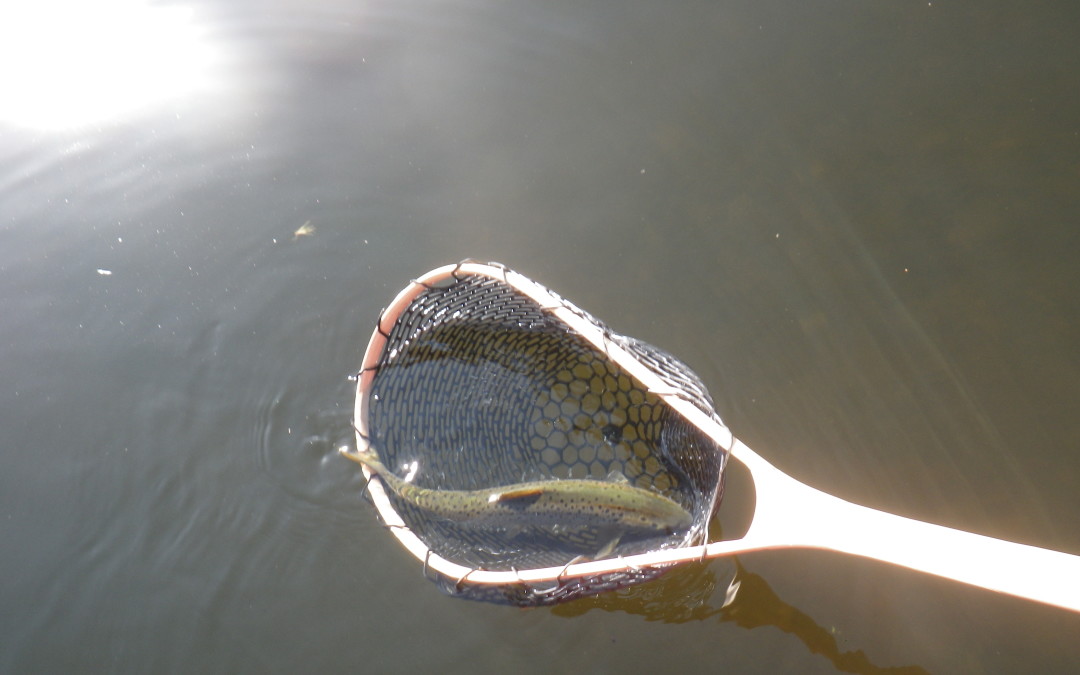With the milder winter many of the lakes and ponds in the southern part of the state shed their covering of ice early. The ice fishing season was fair at best and some larger lakes never safely iced over, so they received minimal fishing pressure. That bodes very well for the start of this open water season. The state also helped out eager anglers and opened all bodies of water, which include rivers, brooks and streams, a couple of weeks early. The fish will still be a little lethargic so slow down your retrieve and be patient. You may not get many opportunities for fish, but some of the biggest trout and salmon may show up, so you will need to be ready. Some days you may be surprised by how active the fish are so pay attention and enjoy the moment when it comes. This week we had one of those trips that does not always occur. The fish were very willing and many fish came to net. Dan had just uncovered his boat so of course we had to make sure everything still worked. Consider it a “guides” day off kind of trip. Make sure everything works so you do not have any break-downs or delays while with a client. We launched in the morning with all of the fixins for a fish chowder and all of the hope the first day of open water fishing always brings.
Being the only one at the launch is always exciting especially during the first few trips of the year. The water temperature was only 38 degrees and the wind was building to 25 miles per hour so we played it safe and stayed within the calmer confines of the river. All through the river system we marked fish at many depths, but we were not successful in trolling sewn smelts, lures or streamer flies. The fish were dispersed equally throughout and not just in the predictable holds and lies. As the weather improves, and especially when the smelts begin their spawning runs, the action within the river should improve dramatically. When we reached our spot we were happy to see that we were the only boat. Right away I knew the day would be good as I hooked and lost a salmon within the first fifteen minutes. Shortly after that the salmon came to the net frequently and our day was looking up. Now the most important key to fishing this time of year is making sure that your streamer or lure is presented near the bottom and your retrieve should be slower than normal. Slow long strips of my sinking fly line did the trick today. However, try and change it up now and then. On one cast I was not very pleased with I tried to bring the line back in fairly quickly and a salmon took my streamer very aggressively near the surface. You never know, so change it up now and then and see what happens.
After a productive morning Dan and I headed back to a campsite on the lake to make our fish chowder. Now our initial plan was to troll on the lake and pick up a lake trout or two for the chowder. As we did not make it out on the lake we were without a fish to add to the chowder. This was solved very simply as one of the salmon that we caught that morning was missing one of its gill plates. I could see the red gill exposed as I brought the fish to the surface. I do not normally keep fish anymore, but this was an easy decision to make. We needed a fish for the chowder and this fish was most likely going to die during the spring. Now our chowder was going to be complete. Add in some hot coffee and this lunch hit the spot and left Dan and I ready to get back on the water. Nothing picks you up on a cold windy day like a warm bowl of chowder.
While we were having lunch we were also witness to a potential disaster. A boater was out in the channel pulling some of the driftwood out of the main part of the river into an area where boaters would not be traveling. We also observed that this boater did not have a life jacket on. As I noted earlier the water was only 38 degrees and hypothermia would not take long to set in if he fell in. While having our chowder we both noticed that he was pulling a fairly large tree and he was close to full throttle with his old Evinrude motor, but was not moving very fast due to the weight of the tree he was towing. When he was close to reaching his destination the line snapped and his boat shot forward violently and almost pitched him over the end. He was also standing up in his boat, which added to the potential disaster. He managed to hit the throttle and stop his boat, but Dan and I looked at each other in disbelief. We both started talking about our strategy if we were put in a position to having to save him from the freezing water if he went in. I then turned to Dan and asked “what if we weren’t here eating lunch?” That was a sobering thought as he was across the river from his home with no life jacket. His odds if his boat kept going would have been very low. Just makes you think about what could have been. Some of the best advice I can give is always plan for the worst and hope for the best. If you are ready for what could happen you stand a much better chance of returning home.
After watching the boater return home we packed up lunch and headed back up river to chase a few more salmon before the day ended. On our way up river we rigged up with sewn smelt, hoping that the familiar bait would entice a salmon or two to come to net. We were not so lucky, but if you are traveling to a spot it never hurts to try something. You may be surprised. I am reminded of a seminar that Bob Clouser gave once regarding his experiences with his close friend Lefty Kreh. He talked about not being scared to try something new as you may find the results you were hoping for. This has served me well over the years. Even though we did not pick up any fish on the way up river we are always noting things for the future. For instance we marked fish on the fish finder in different places than years past and will serve us well when the fishing picks up. The fish would not be holding there if there was not something that benefitted them. Note things like this in your travels as you never know when you can pull from those experiences and be successful in hooking into some nice fish in spots that others would just pass over.
When we reached our spot it only took Dan one cast to hook into his first salmon of the season. On the next two casts I hooked into some nice salmon and Dan just threw his hands up and said I give up. We have been through this before on this stretch of water with the same results. Goes to show that two anglers can be using similar flies and same techniques, but one just seems to have the specific retrieve that the fish are looking for. Or just simply that one angler lets his fly sink deeper than the other. The most difficult part of using sinking lines is the waiting game. Depending on the depth you may be waiting a while. It is vitally important to wait until you are at the depth that you want. Think of it this way: You could make 1000 casts at the wrong depth and catch nothing or make one cast and wait and catch the fish you wanted.













